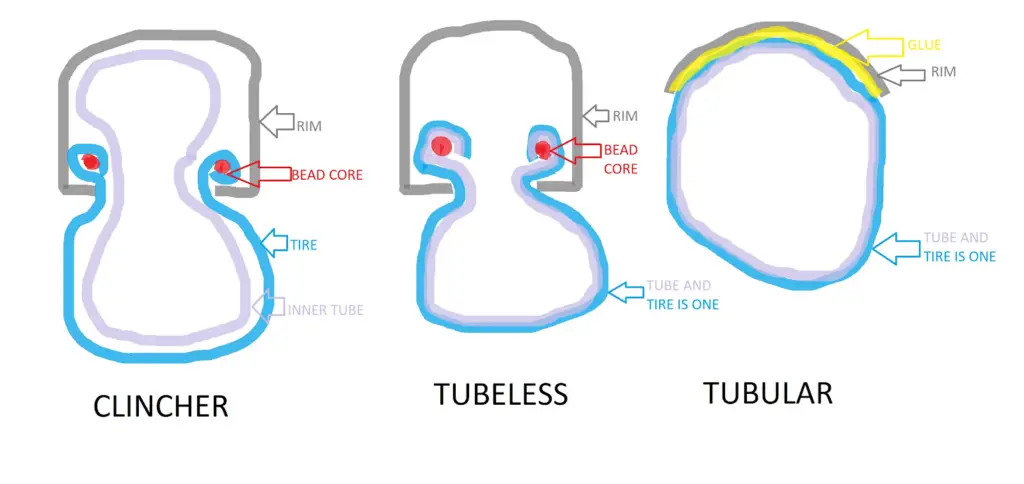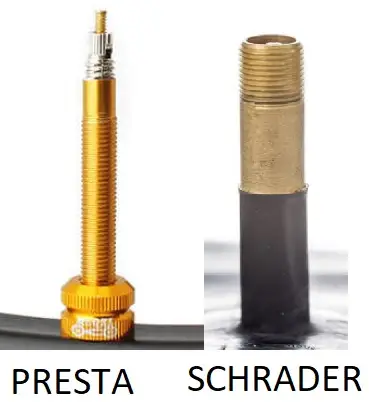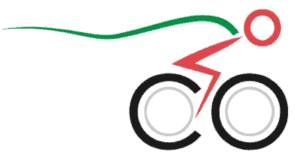There are tires with tubes and those without tubes (the tubeless variety), although the majority of bikes out there have them. This post will deal with why that is, as well as how to tell the difference between the two options without having to check every tire you see with your Swiss Army knife.
Most bicycle tires have tubes, although not all of them do. Tubes give you some distinct advantages, however there are also drawbacks, which is why there are other types of tires on the market as well. Because most tires have tubes, it is an indicator that they are generally the best option for a bike.
Do all tires have tubes?
Most tires have tubes, but not all of them do. Good ol’ Mr. Dunlop invented the bicycle tire with tubes in the late 1800s, and that’s the way things were until just before 2000, when the French company Mavic introduced the tubeless tire onto the market, with their patented UST (Universal System Tubeless) standard.
Initially, mountain bike enthusiasts jumped on the tubeless bandwagon, perhaps due to the prospect of not having to worry about flats so much as well as being able to have a more comfortable ride (one of the advantages for having tubeless tires on bumpy surfaces). With time, the tubeless wonders began to catch on with gravel bikers and those who prefer traditional road bikes.
Electric bikes built for everything and priced for everyone. Shop Rad Power Bikes, America's #1 electric bike brand. Get out. Go further. Ride Rad.
This said, and as the intro to this article suggests, most bikes still have tires with tubes in them. There are two types of tires with tubes: “clinchers” and “tubular,” and most bikes tires that have tubes in them are of the “clincher” type. So how do you tell the difference between the two?
Tubular tires are sewn together at the edges (if you look at a cross-section, it looks like a circle), with the tube inside. The tire is then glued to the rim to keep it in place. On the other hand, if you look at the cross-section of a clincher, it looks more like a horseshoe: the tire beads hook into corresponding hooks on the rim that keep it in place, and the tube is surrounded partly by rim, partly by tire.

Do my bike tires have tubes?
So without having to get all Swiss-army drastic on your tires, how do you figure out if your tires have tubes or not?
A simple way to check is to look on the tire itself for indications that it may be tubeless. The most obvious one is when “tubeless” is written on it. Sometimes, abbreviations will be used, but these can depend on the tire company. If you find an acronym on your tire that has a “TL” in it, you may have yourself a tubeless tire. Do a quick Google search, and you will probably find your answer easily.

Yet, another way you can see if you have a tire with tubes is by taking a close look at the valve for putting air in the tire. If you see a gap between the valve and the tire, chances are your tires have tubes. If you see that the valve appears to be fixed to the rim, then what you most likely have is a tubeless tire.

If you are not able to clearly see whether or not there is a gap between the valve and the tire, try letting the air out of one of the tires. Once you let the air out, if your tires have tubes, you will be able to see that the stem of the valve will be attached to the tube, not to the rim, and the gap between the rim and the bottom of the valve will become more pronounced.
Why do most tires have tubes?
To help us understand the reason why most tires have tubes, it may be helpful to ask why it is that the biking world hasn’t gone completely tubeless. As a principle, tubeless tires require that no air is able to leave the space encapsulated by the wheel and the rim. This “chamber” has to be completely sealed. This can be a challenge, and it requires you to take some gear with you in case air starts leaking.
Another reason is that it is still easier and cheaper to maintain clinchers than tubeless tires. The former requires a few simple maintenance habits, while the latter can be quite maintenance-intensive. We will discuss this further in the pros and cons of tires with tubes.
Do road bikes have inner tubes?
Like with other tires, those road bikes can either have or not have inner tubes. Most road bikes still have inner tubes in them.

What size tube fits a 700x35c tire?
If you have 700x35c bicycle tires and you get an irreparable flat, it might be time to go shopping for another tube. The first number (700) refers to the diameter in millimeters, while the second number (35) refers to the width in millimeters. Don’t worry about the “c,” as it is simply a remnant of the French system for bike tire sizes.
The tubes you will have to look for will be the diameter (700) times the width, which will usually be part of a range. For example, you might find a tube that is 700×35-40c, which will work perfectly in a 700x35c tire. I suggest buying your tube in millimeters, and not looking at any in inches, as sometimes the measurements can be off.

One last word of warning before buying your tubes. Make sure you are getting the tube for the type of valve you have. If you have tires with Schrader valves (the typical ones), the tubes for Presta valves (the skinnier type) will not work. If you would like to understand more about these valves, check out this post.
Advantages and disadvantages of having tubes
Firstly, if you are looking for a quick commute, tires with tubes are definitely the way to go. Secondly, if you are careful and perform a few simple periodic checks, tires with tubes take up a lot less time to maintain than tubeless setups, which can be quite time consuming to deal with.
On the downside, pinch flats are quite common in tires with tubes, and these can take time to repair. Pinch flats (or “snake bites”) happen when you run over an object (usually something with a pronounced edge, such as a curb) bottoming out your tire and the inner tube gets stuck between the rim and the object. However, if you keep the tires inflated at the correct pressure, you can avoid these just as easily as you can get them.
Another con for tires with tubes is that your commute can be quite uncomfortable if the route you travel to and from work is on rough gravel or cobblestone (or any other bumpy surface for that matter).
If you want to find out more about the tubeless option, you can check out a post I wrote, which explains how tubeless tires work and how to weigh up whether or not letting go of your time-tested trusty tubes is a good idea. You can read the post here.
Conclusion
In summary, as you can see from the various characteristics of tires with tubes versus those of tubeless tires, the former is still a better option for most bicycles, which is why most bicycles still have tubes today.
Happy riding!
